Butterflies in Our Backyard
Local wildlife photographer P. Chris Christofferson explains why our butterflies are becoming more scarce, and what we can do to change that. Her luscious photographs of local varieties may have you planting your own butterfly garden tomorrow!
- story and photographs by P. Chris Christofferson
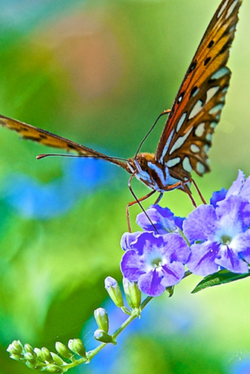
The Internet sites below are fascinating and helpful to understand how we can all do more to help them repopulate—not only by planting their preferred nectar flowers, but by also planting hosts for egg deposits.
Each of these sites has general butterfly garden facts, with links to more specific information:
The eye of a butterfly is compound and immobile, but even though it's near-sighted, it can see a wide range of color. It is particularly attracted to red, orange, yellow, purple, white, and some pinks planted in the sun or partial shade. The butterfly favors compound flowers with multiple blossoms and short nectar tubes for its proboscis, especially those with nectar comprising up to 20% sugar. Placing flat rocks in the garden is recommended so the butterfly can rest and warm its wings in the sun. Who knew! The literature notes, and I’ve verified in my gardens, a few of their more favored flowers: bottlebrush, bougainvillea, azalea, honeysuckle, goldenrod, penta, sunflower, poppy, coneflower, jasmine, lantana, milkweed, ruella (Mexican petunia), zinnia, butterfly bush and blue salvia (last four huge favorites in my gardens). They seem to spurn my roses, petunias, impatiens and vinca, however. 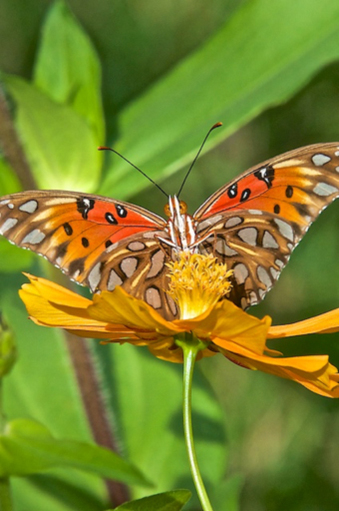
All butterflies transform through the same life cycle:
The egg hatches to a caterpillar, which eats the eggshell's chorion (or membrane) first. Then, the caterpillar starts devouring its host’s leaves, going through stages of growth, called instars. The number of stages depends on the species. Then it pupates within a chrysalis and emerges, astonishingly, as a glorious mélange of color. A caution: spraying insecticide in the garden, even the surrounding yard, can kill the feeding butterflies and caterpillars. Pesticides do much more damage than any natural butterfly predator. There are five butterflies I’ve photographed in my yard and researched: Clouded Sulphur, Eastern Black Swallowtail, Giant Swallowtail, Gulf Fritillary and Monarch. The Monarch Butterfly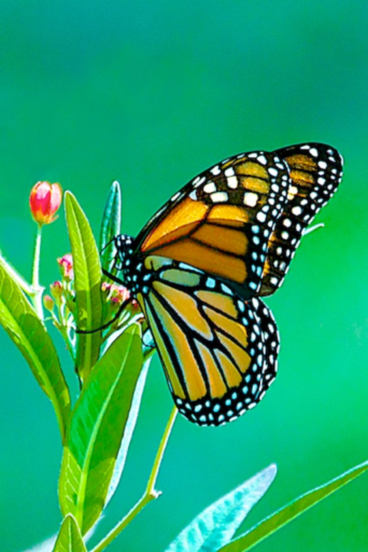
The yearly migration of the king of butterflies from Canada to Mexico has begun! The two visiting since mid-August are, hopefully, heralds of more on the way.
Last year, this monarch pictured is the only one which came to feast on my nectar gardens and milkweed. Milkweed is literally the lifeblood for the continued existence of this butterfly species. The plant is the only host on which the monarch will lay its eggs and only leaves its caterpillars will eat! I had internet shopped several kinds of milkweed seeds to be this year’s hosts, but the plants stayed so puny, I bought this year’s milkweed plants from our local nurseries. Monarchs are the only butterfly to fly a migration pattern like some birds. It is an amazing story of a 3000 mile one-way journey flying north and eastward in the spring from a very constrained area in mountains of southern Mexico and then three generations later arriving in the northern U.S. and Canada. Then, for some monarchs, a single, fragile, almost weightless fourth generation migrates the entire 3000 miles back to Mexico in the fall while others overwinter in the deep south! The fourth generation nectars heavily and can actually gain weight during the migration south by storing fat in its abdomen which must sustain it for months while overwintering in the trees in that one locale in Mexico. In the spring, the first migrating monarchs from Mexico mate, and in March and April deposit the first generation on a milkweed. Four to five days later, the egg hatches to a larva, caterpillar. After about two weeks of eating the milkweed host and growing through three to four instars, it is full grown and finds a stem or leaf to attach itself to with a silk thread forming a pupa. Then the pupa undergoes metamorphosis inside the chrysalis for about 10 days and emerges as the king of butterflies! 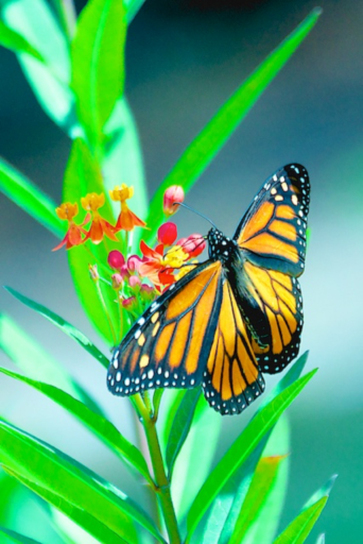
Ever flying northward, that second generation feeds on flower nectar for only about two to six weeks, mates, lays its eggs and dies. Also always flying northward, the second generation, born in May and June, and the third generation, born in July and August, go through this same short life cycle. The fourth generation can be astoundingly different, and can live as long as nine months!
From the summer breeding grounds in northern U.S. and Canada, some of the monarchs can travel the full 3000 miles back to the mountains of Mexico, roost through the winter months and lay the next generation of eggs before dying for the first leg north - again. However, the generalizations cited in the articles are not universally true. In speaking with Mr. Scott Peyton at the Miss. Museum of Natural Science in Jackson, I learned that the fourth generation may lay eggs on milkweed along the coast in August and September, then die. Some of the emerging monarchs in September and October overwinter here and south Florida or continue the migration southward to the mountains in Mexico. That information answered my puzzling question of why should we have milkweed planted here for the migrating fall monarchs. He relayed a conversation he had with Dr. Bill Stark at Mississippi, who has tagged some newly emerged adults in Mississippi in the fall and recaptured them overwintering in Mexico. Mr. Peyton had generously researched some of my other questions and provided this link, Project Monarch Watch, which is an incredibly rich source material. Their map of the fall migration is also quite informative. Alarms are going off in scientific communities about the great peril for the continuance of this marvelous monarch migration. The U.S. Fish and Wildlife Service has stated that from one billion monarchs in the 1970s there are only about 30 million remaining.
Known killers are the millions of total lost acres of milkweed from highway building, urban sprawl, and mammoth areas of land under cultivation in the Midwest with concomitant insecticide and herbicide spraying. The current drought in the Midwest is also taking its toll.
The Fish and Wildlife Service has formed a partnership with two private conservation groups, The National Wildlife Federation and National Fish and Wildlife Foundation, to start planting milkweed in any open space possible and giving seeds to everyone interested. The U.S.Fish and Wildlife Service is distributing seeds in refuges and in a 200,000 acre corridor along Interstate 35 from Texas to Minnesota, the path of 50% of the migrating monarchs. Some organizations are giving away free milkweed seeds to schools and non-profits. St. Louis and Charlotte are two cities declaring themselves sanctuaries. Florida is urging the planting of milkweed. And some local citizens are investigating what it would take for Bay St. Louis and Waveland to be declared Monarch sanctuaries. There are some studies which support the position that even though the numbers of the overwintering monarchs in Mexico are drastically reduced, the summer butterfly numbers are rebounding. One theory is that global warming is pushing the monarch farther north so that the single monarch flight south for the winter is getting just too far for one butterfly, the reason those numbers are in such decline. The scientific community is quite divided about this, though. Regardless, for all of us, let the lasting imprint be: grow Milkweed and feed, feed, feed! Eastern Black Swallowtail Butterfly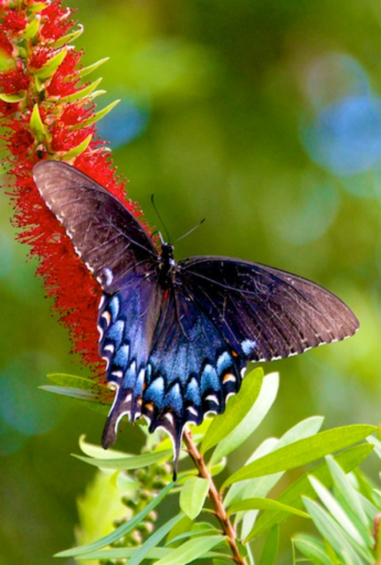
The Eastern Black Swallowtail, Papilio polyxenes asterius, may be known by other names such as American swallowtail, parsnip swallowtail, parsley swallowtail, celeryworm swallowtail and caraway worm swallowtail. A bit of lepidopterist trivia: genus name papilio is Latin for butterfly, and polyxenes is from Polyxena, the daughter of Priamos, King of Troy in Homer’s Iliad.
It lives throughout southern Canada, eastern and mid-western to the Rockies and southwest into Arizona and northern Mexico, in “uplands and wet areas-prairies, fields, flatwoods, pine savannas, roadsides, weedy areas and gardens.” The undersides of the male and female wings are identical, but the larger female has a more prominent powdery, iridescent blue on the upper surface of the hind wings. I think this one I photographed must be a female. The life cycle of the Eastern black swallowtail has the same four stages as all butterflies: eggs to caterpillars (larvae), to pupae in the chrysalis, to butterfly. This spectacular time-lapse slide show follows the growth of the chrysalis and the emergence of the butterfly. 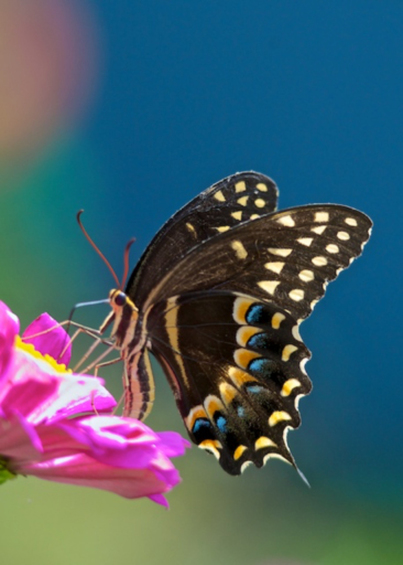
They lay their eggs singly on specific host plants (listed in the referenced article), including the very poisonous spotted water and poison hemlock. So that I can support a generation, next year I’m going to plant some of their more agreeable hosts like parsnip, Queen Anne’s lace, celery, dill, parsley or sweet fennel.
According to the article, the egg stage lasts four to nine days, larval stage ten to 30 days and pupal stage nine to 18 days, except for the overwintering pupae of third generations in the south. The Eastern black swallowtail has three instars in the caterpillar stage, and the pupa in the third generation spends the cold months hanging in a brown, wrinkled paper skin chrysalis until the spring warmth to emerge. How amazing the genetics change for repopulation! Butterflies utilize mimicry of their coloration as a defense against predators like wasps, but the Eastern black butterfly caterpillar has evolved to brandish a superb weapon. If threatened, it rears up and waves horn-like organs, osmeterium, attempting to smear the predator with a chemical repellent! Clouded Sulphur Butterfly
The Clouded Sulphur butterfly, Colias philodice, used to come through in groups of ten or so, but no more. This year only one has visited so far.
A Clouded Sulphur is distinguished from a regular Sulphur by its dark border. They fly close to the ground in open areas over yards and fields, roadsides and stream beds. A female Clouded Sulphur lays one egg on its host plant, which can be black locust, clover, asters, peas, vetch and alfalfa. One female lays several broods (batches) each year. If it gets cold before the butterfly emerges from the chrysalis, it will overwinter, with the Clouded Sulphur emerging in the spring from March through September. Given clover is everywhere in Waveland, I don’t understand why the numbers of this butterfly have dropped so precipitously in my gardens. This article has a great picture of what I often saw, with five or six of them grouping, but didn’t know the phenomenon had a name. Puddling. They group together on mud puddles, animal poop, or in my case, wet mulch, and drink the moisture. I so miss their happy dances! Gulf Fritillary Butterfly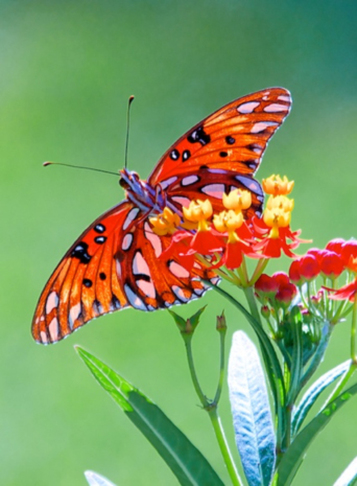
A lot of Gulf Fritillary butterflies, Agraulis vanillae, used to come to my gardens every summer. In 2015, I haven't seen any yet.
The Gulf Fritillary is supposed to be common across the extreme southern parts of the United States, as well as Mexico, and Central and South America. It gets its name from crossing the Gulf of Mexico. In the U.S., during the spring, adults migrate northward in the southeast into temporary breeding grounds. Then, late summer and fall, they migrate southward and overwinter in frost-free areas. The females are larger and darker than the males, but I've either seen only one sex, or just can’t tell the difference. They are so beautiful with the distinctive iridescent silvery sheen on the undersides of the wings. 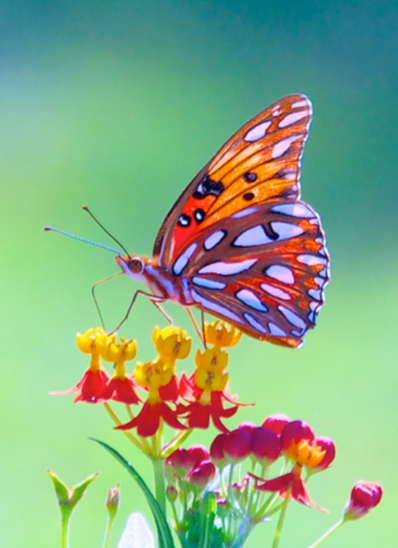
The eggs are laid singly on its host plant, which I learned is only the maypop or other Passionflowers. The caterpillar, which emerges from the yellowish egg after four to six days, is really scary looking, bright orange with black spines running the length of its body, but the spines are soft to the touch. So the literature attests, but I’m not touching it!
First thing the Gulf Fritillary caterpillar does, like all of them, is eat the crunchy eggshell, before denuding its host Passionflower. However, some red and blue passionflowers are toxic to the Gulf Fritillary, and the caterpillars die after eating these. An evolutionary hiccup, it seems to me! The caterpillar, larva, grows during the course of about two weeks, shedding its skin (exuvia) and eating it, through three instars. The Gulf Fritillary caterpillar travels from the host plant and pupates into a distinctive J position. It’s described here and pictured, looking like a brown, dried up leaf, a great protective mimetic. The caterpillar is toxic to birds, which are warned away by its coloration. But some wasps and some larger caterpillars will eat them. Giant Swallowtail Butterfly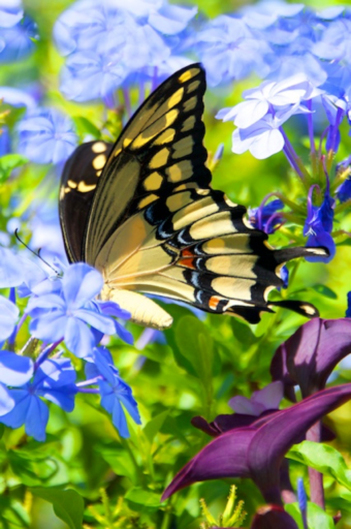
The Giant Swallowtail Butterfly, Papilio cresphontes Cramer, is spectacularly beautiful and my personal favorite. Last August, I had the most delightful day photographing three Giant Swallowtails as they danced together through the sky and fed in my gardens, just as I had planned it!
The Giant Swallowtail is truth in advertising with forewing span averaging 14–17 cm, and with uniform male and female coloration as far as I've read. The Giant Swallowtail ranges from Ontario down to the southern states, Caribbean, Mexico and Central and South America, and west to the central plains and Rockies. An intriguing fact is that Giant Swallowtails court and copulate in the afternoon. The Giant Swallowtail lays its eggs on common rue, hoptree, gasplant, torchwood, and most citrus species. It’s considered a pest to some as the larvae, caterpillars, can quickly exfoliate a small citrus tree. My husband and I, however, are delighted to sacrifice our small lime trees as hosts for their eggs. 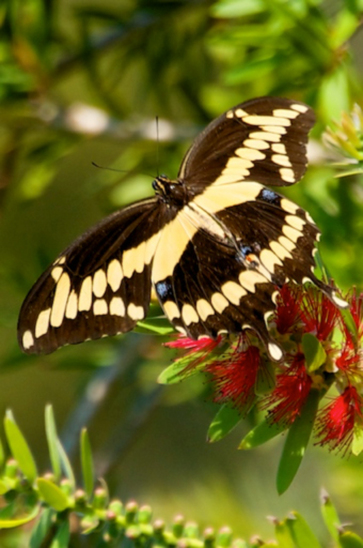
When the eggs hatch, they evolve through five instar stages of larvae and resemble bird droppings as protective mimicry. I never saw them on our limes because, unfortunately, orange and black insects ate the eggs. Figures 8,10 and 11 on this site are of a mature larva resembling a snake in a striking pose. And with the osmeterium everted like a forked tongue, the photos are really striking. The photos of the pupae in the chrysalis attached to their surfaces by a silken thread are great examples of evolutionary protective mimicry. I haven’t seen one, yet.
Predators of the larvae are certain parasitic wasps, flies and even birds. But its coloration is a protectorant as well as their osmeterium glands grown in the fourth and fifth instar. A toxic glandular secretion, which smells like rotten eggs, is aimed at small predators like ants and spiders. I live in Waveland, off Nicholson. I would love emails from Waveland or Bay St. Louis residents with location information, and your observations of the number of these or other butterflies in your yards this summer as compared to previous years. P. Chris Christofferson, P. Chris Photos, [email protected] Comments are closed.
|
Categories
All
Archives
July 2024
|
Shoofly Magazine Partners
Our Shoofly Partners are local businesses and organizations who share our mission to enrich community life in Bay St. Louis, Waveland, Diamondhead and Pass Christian. These are limited in number to maximize visibility. Email us now to become a Shoofly Partner!

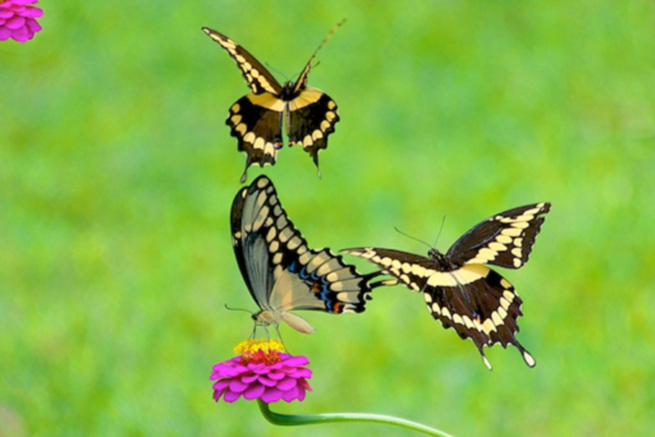

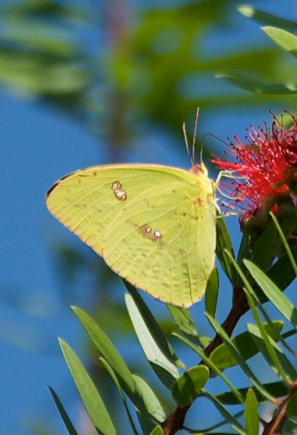
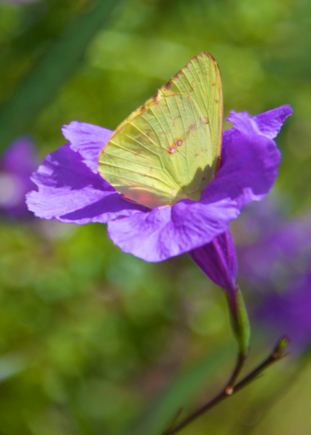
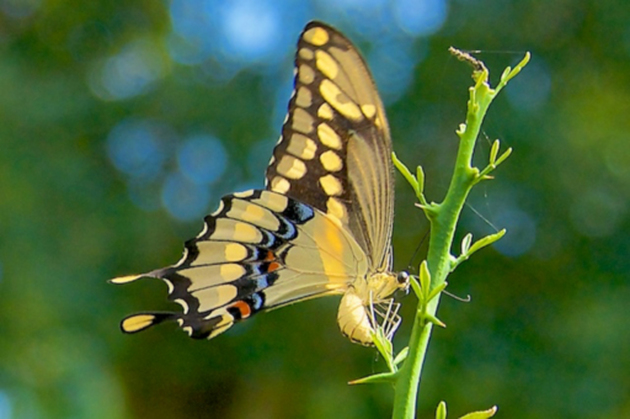

























 RSS Feed
RSS Feed























